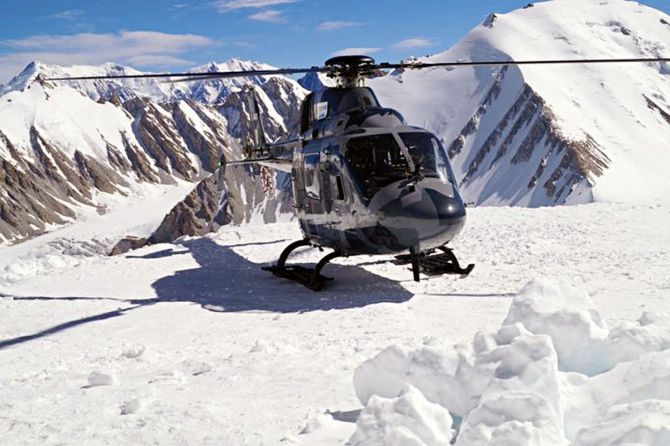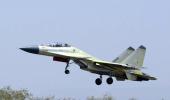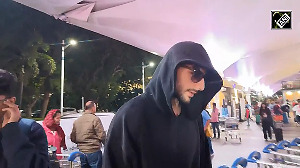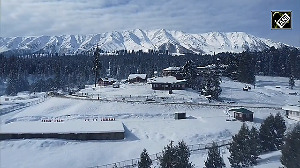The LCH can provide our soldiers fire support in 15,000-16,000 feet-high contested areas like Depsang, Galwan and the heights north and south of the Pangong Tso, where Indian soldiers are facing off against Chinese intruders, reports Ajai Shukla.

In a double assertion of its proficiency in building different kinds of helicopters, Hindustan Aeronautics last week achieved two significant landmarks: The company rolled out its 300th Dhruv advanced light helicopter (ALH) for the military; and also conducted the inaugural ground run of the first light combat helicopter (LCH) it is series-producing for the Indian Air Force.
While the Dhruv, with over 280,000 flying hours logged, is already the backbone of the IAF and the Indian Army's light helicopter fleet, the LCH is a crucial new induction that would play an important role in any armed confrontation between Indian and Chinese troops on the Ladakh border, or in the looming militarisation of the Line of Actual Control.
The LCH project was sanctioned after the 1999 Kargil War, when a dire need was felt for a weapons platform that could provide dedicated fire support to soldiers at high altitudes, who can carry only a limited amount of weaponry. The ministry of defence accordingly sanctioned the LCH project in October 2006.
Fourteen years later, the LCH has become a reality.
HAL has agreed to build the first 15 'limited series production' LCH for about Rs 125 crore (Rs 1.25 billion) per helicopter -- about one-third the cost of each of the 28 AH-64E Apaches attack helicopters the government is importing from the Boeing Company.
True, the Apache is a bigger, more heavily armed gunship with more advanced avionics and battle-tested night fighting capabilities. But, for those reasons, it is expensive and the army and IAF will be making up the numbers with LCHs.
The military is yet to sign a contract for 15 LCHs, but HAL has decided to start building the helicopters with its own funds. HAL's board has sanctioned Rs 1,800 crore (rs 18 billion) for this and production is well along.
A key attribute of the 5.8-tonne LCH is its ability to fly and fight at the altitudes the army is deployed at.
In tests conducted in the Siachen Glacier sector, the LCH has demonstrated its capability to land and take off at altitudes of 5,000 metres with sufficient fuel and weaponry for combat missions against even higher targets.
Driving this performance is the LCH's twin Shakti engines, especially designed by French firm, Safran S.A., to deliver extra power at high altitudes.
That makes the LCH an ideal platform for providing infantry soldiers fire support in 15,000-16,000 feet-high contested areas such as Depsang, Galwan and the heights north and south of the Pangong Tso, where Indian soldiers are facing off against Chinese intruders.
The military has already projected to HAL an eventual requirement of 65 LCH for the IAF and 97 for the Army.
For such a small, light helicopter, the LCH is a formidable fighting machine. Its two pilots, who are seated one behind the other in a slim tandem cockpit, can choose between a menu of weapons that they fire using a helmet pointing system that lets a pilot aim at a target just by looking at it.
The LCH's weapons options include a nose-mounted, 20-millimetre turret gun; or 70-millimetre rockets; or air-to-air missiles that it carries on stub wings. The LCH is the first helicopter to fire air-to-air missiles against a flying target.
The LCH is also designed to carry anti-tank guided missiles that can knock out enemy tanks at ranges of up to 7 kilometres.
Allowing it to survive on a battlefield where it will be a prized target, the LCH is protected by a range of devices.
The pilots are shielded against ground fire by armoured panels around the cockpit and by a bulletproof windshield.
The LCH has self-sealing fuel tanks that automatically seal up bullet holes with a rubber compound. It has damage-tolerant rotor blades and a main gearbox that can run for 30 minutes even after a bullet hit drains out all its oil.
The LCH is also fitted with an electronic warfare system that detects enemy missiles; and then scatters flares and chaff as decoys to lure the incoming missile away from the helicopter.












 © 2025 Rediff.com -
© 2025 Rediff.com -